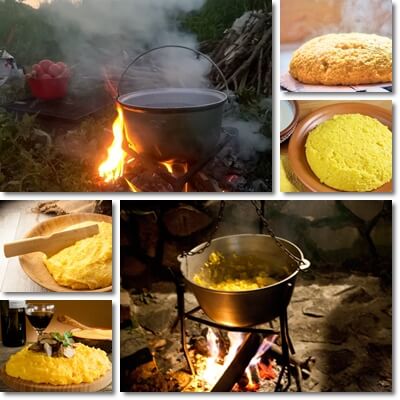Polenta is a cornmeal dish of Italian origin, but present in gastronomies around the world. The different variations that exist have made the dish an ethnic food of many cultures, despite it starting out as peasants food.
Polenta is rich in carbohydrates and provides small amounts of protein with a good amino acid profile.
The dish is a source of B vitamins, notably thiamine, pantothenic acid and folic acid, as well as phosphorus, magnesium, potassium, manganese and zinc and has a moderately low calorie content and no gluten.
What is polenta?
Polenta is a traditional ethnic food made primarily from boiled cornmeal (maize flour or corn flour). Polenta is a mush, porridge or cereal pudding. Although the name now refers to a dish made exclusively from cornmeal, in the past polenta was made with whatever ground starchy grains were available, including spelt, millet and buckwheat.
The dish is prepared by boiling, but can be baked, fried or grilled afterwards for more variety or as part of more complex dishes.

How is polenta made?
There are multiple polenta recipe variations. The traditional method involves boiling cornmeal in water in a large pot. Typically, 5 times more water than cornmeal is used to make traditional polenta which, upon cooling, becomes a firm dish that can be cut into pieces. Traditionally yarn or thread was used to portion the settled polenta.
Coarse cornmeal was often used to make the dish, but nowadays a finer ground cornmeal is available for a softer, creamier texture. The most interesting aspect about making polenta is the fact that it requires around 30 to 45 minutes of boiling and constant stirring in order for the starch in the cornmeal to become gelatinous and give the polenta its characteristic consistency.
Making large amounts for large families could take up to 4 hours, but this was mainly because people would make enough polenta to last for the next day too. In the past, polenta was made on an open fire in a large cast iron cooking pot known as a cauldron and it took a lot of time to even bring the water to its boiling point.
Constant stirring with a thick wooden roller was needed to avoid lumps of uncooked cornmeal forming in the polenta. The polenta had to be allowed to cool down in the pot until it was thicker and would start to settle, then the cauldron would be tipped over and the polenta dumped on a clean wooden table (it was still very hot) and allowed to settle further.
How to make polenta at home
However, home-made polenta is easier to make, assuming you are making 6-8 portions. You only need a 2 liter pot which you should only fill 3/4 to avoid polenta burns. Pour the water in the pot, salt and bring the water close to the boiling point, then add your cornmeal or corn flour little by little while stirring with a long wooden spoon or whisk (the packaging should show the amount needed to make a certain number of portions).
It should take a few minutes for the polenta to start thickening and, from that point on, keep stirring for 20-25 minutes, depending on the case. Your polenta is going to look liquid at first, so don’t let that fool you into filling your pot halfway with cornmeal. It’s important to stir from the very beginning or else the cornmeal will settle to the base of the pot, clump and even burn.
If any lumps form, just press them against the side of the pot. Also, to avoid burns from the scalding hot bubbles, leave at least 1/4 of your pot empty and keep stirring rhythmically until it’s done. Remember to also hold on to the pot once the polenta has thickened to avoid spilling it, and use an oven glove or pot holder.

Polenta variations and recipe ideas
Regular cornmeal takes longer to cook, but pre-cooked cornmeal is also available and can reduce cooking time to around 15-20 minutes tops. Because polenta bubbles intensively and can splatter over short distances, be careful when stirring it.
The original polenta recipe requires a coarse cornmeal and is made to have a thick, extremely firm consistency.
It was often poured directly from the pot onto a wooden table or large cutter (see the image above). Softer polenta can be made by adding less cornmeal to the water and using a finer cornmeal can give it a creamier consistency.
The dish is present in cultures throughout Europe, Northern Africa and the Americas.
Some cultures prepare a firm polenta to eat instead of bread or other cereals with a main dish.
Polenta makes an excellent side dish for stews, especially heartier ones made with beef or pork, tomato sauces and vegetables. Italian cuisine pairs it with various cheeses and mushrooms, even fish.
The traditional Romanian polenta, called ‘mamaliga’, would be made in a deep cast iron pot and eaten with raw onions and cow, sheep or goat cheese.
For the poor families, it would substitute bread, which is why Romanian polenta would be firm, lending itself to be cut into slices like bread. It was also commonly eaten in cow’s milk.
A favorite recipe was hard boiled eggs mixed with butter, chunks of matured cheese, sometimes fried homemade sausages covered with hot polenta.
A loose polenta can be mixed with sugar and eaten as a desert. It was also commonly eaten with fried forest mushrooms and crushed garlic mixed with salt and water or sour cream and meat stuffed cabbage rolls.
Nutrition facts and health benefits of polenta
What are the properties and benefits of eating polenta? The dish has a humble nutritional value but provides several beneficial health effects as a result of a moderate calorie content, lack of gluten and good antioxidant value. Here are the top 5 nutritional facts, properties and health benefits of polenta:
1) Moderately low in calories
Polenta is basically cornmeal or maize flour diluted with water. And whole grain yellow corn flour has around 420 kcal per cup (117 g). While the calorie content cannot be measured exactly, a serving of traditional polenta (firm and consistent) often has an estimate of 80-100 kcal/100 g, less than half compared to plain white bread (read more about polenta vs bread: which is healthier?).
2) Polenta is gluten free
Polenta is actually gluten free because it is made from maize or corn which lack the protein gluten. This protein is what helps wheat products rise during baking.
However, many people experience adverse reactions to gluten in food and develop diseases and disorders such as Celiac disease, wheat allergy or gluten sensitivity. An intolerance to gluten often causes symptoms such as bloating, diarrhea or constipation and stomach pain.
Fortunately, avoiding gluten products restores normal digestive functions. In addition to corn flour used to make polenta, rice and rice flour also lack gluten.
3) Source of pigmented antioxidants
Corn flour can be made from any variety of corn, including yellow, white or purple-blue corn. Each and every one of the natural pigments that give corn its specific color is actually an antioxidant. Antioxidants are scientifically proven to scavenge for free radicals, combat oxidative stress, limit damage to cells and DNA caused by oxidative stress and even repair cell damage.
A high intake of antioxidants from food is postulated to protect against inflammation and chronic disease. If you choose yellow corn, you will be getting yellow and orange carotene antioxidants. If you choose blue and purple corn, you will be getting blue and purple anthocyanins, proanthocyanidins. In addition to the pigmented antioxidants, there are many other polyphenols in corn and corn flour with important antioxidant effects.
A purple-blue corn flour polenta, although not traditional polenta as we know it, provides the highest antioxidant value and important anti-inflammatory and free radical-scavenging benefits.
4) Macronutrient profile of polenta
With respect to its macronutrient profile, that is, protein, fat and carbohydrate content, polenta is low protein, very low fat and relatively low fiber, but high in carbs, with a relatively good carbohydrates profile in the sense that is contains plenty of complex carbohydrates.
Eating polenta provides negligible amounts of protein, fats and fiber. At the same time, it is a good source of quality carbohydrates for a good energy metabolism. It is important to remember that polenta is made from unrefined corn flour which preserves all the nutritious components of the corn kernel, hence the reason it is preferred to white refined bread and white rice.
5) Vitamins and minerals in polenta
Polenta has poor vitamin and mineral values. The nutritional value of polenta is overall poor, considering the already nutritionally modest cornmeal is diluted several times with water as it’s cooked. The dish provides small amounts of vitamins B1, B5, B6 and B9, iron, magnesium, phosphorus, potassium, manganese, selenium, copper and zinc. The vitamin B3 in corn, cornmeal and polenta is poorly absorbed.
